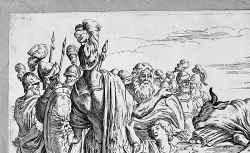Topic: 2. Sacrifice and religion: Comparisons, Antiquarians, Anthropology (16th-18th Century)
Religious sacrifices across various cultures and contexts sparked widespread interest in Early Modern Europe. As Christianity expanded into regions inhabited by "infidels" and "pagans", Europeans encountered a diverse array of sacrificial customs, ranging from the Sati rituals in India to the Aztec sacrifices in the Americas. This cross-cultural exposure captivated a wide audience, including theologians, philosophers, political thinkers, antiquarians, orientalists, missionaries, poets, artists, and even the general public. These encounters broadened the European understanding of sacrifice and led to a critical reassessment of classical and biblical sacrificial rites. This section includes:
- Sources: A selection of early modern printed materials, which include descriptions of the Americas, Asia, and Africa, alongside antiquarian and philological studies on religious sacrifice in classical antiquity and beyond. It also presents early modern works of ethnological observations and the first attempts to compare different sacrificial practices in various traditions and contexts, laying the groundwork for disciplines like the history of religions and anthropology.
- Iconographic Representations: A rich collection of images from the 16th to 18th centuries, illustrating a range of sacrificial rituals and practices as seen in different cultural and geographical contexts.
- Related Bibliography: An extensive bibliography spanning scholarly works from the 19th to 21st centuries, providing contemporary analyses and interpretations of these early studies and observations.
Ishmael as Abraham’s Sacrifice: Ibn Taymiyya and Ibn Kathīr on the Intended Victim
in: Islam and Christian–Muslim Relations, v. 24 (2013), issue 3: pp.277-298.
Sati Memorials and Cenotaphs of Madhya Pradesh — A Survey
in: Proceedings of the Indian History Congress, v. 62 (2001), issue --: pp.1013–19.
(1663)
from: L'Enea vagante pitture dei Caracci (from the frescos in Bologna, Palazzo Fava)
Accademia dei Lincei, Fondo Corsini, Roma
Sacrifice and Symbol : Biblical Šĕlāmîm in a Ritual Perspective
Stockholm: Almqvist & Wiksell International, 2005.
Il ‘sacrificio’ di ʿAbīd Ibn al-Abraṣ
in: Atti della V settimana di studi “Sangue e antropologia: riti e culto, pp. 477-484
Roma: Pia Unione Preziosissimo Sangue, Centro Studi Sanguis Christi, 1987.
Mojecki, Przecław. Żydowskie okrucieństwa, mordy, y zabobony
Cracow: W Drukarni Jak. Sibeneychera, 1598.
in: Confessionalization on the Frontier. The Balkan Catholics Between Roman Reform and Ottoman Reality, pp.
Rome: Viella, 2019.
Religion in Athens, Rome and Jerusalem in the first century B.C.
in: Annali Della Scuola Normale Superiore Di Pisa. Classe Di Lettere e Filosofia, v. 14 (1984), issue 3: pp.873–92.
Les Essais
Paris: Gallimard, Bibliothèque de la Pléiade, 2007.
De Nieuwe en Onbekende Weereld
Amsterdam: Jacob Meurs, 1671.
Lettres persanes, n. 17
Amsterdam: , 1721.
Hindu Infanticide: An Account of the Measures Adopted for Suppressing the Practice of the Systematic Murder by Their Parents of Female Infants; with Incidental Remarks on Other Customs Peculiar to the Natives of India
London: Johnson, 1811.

